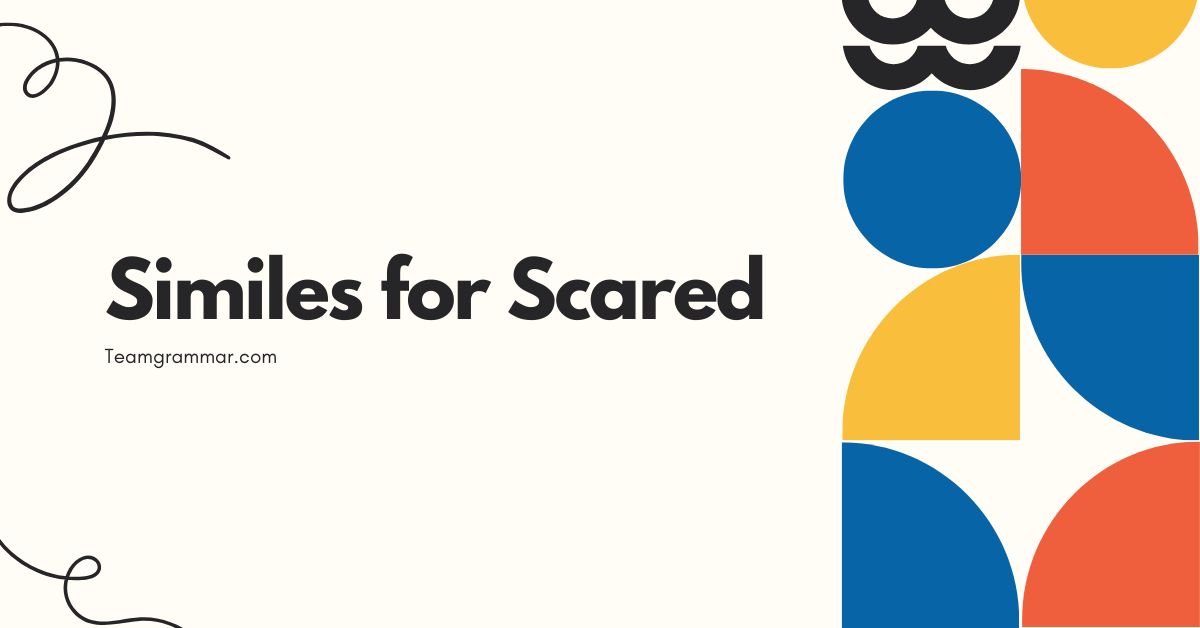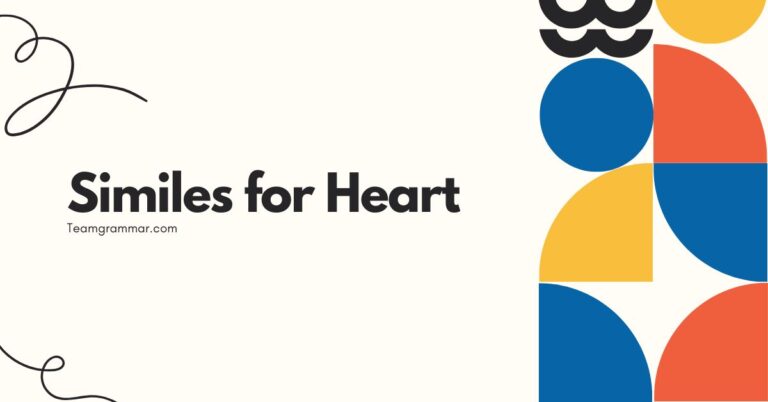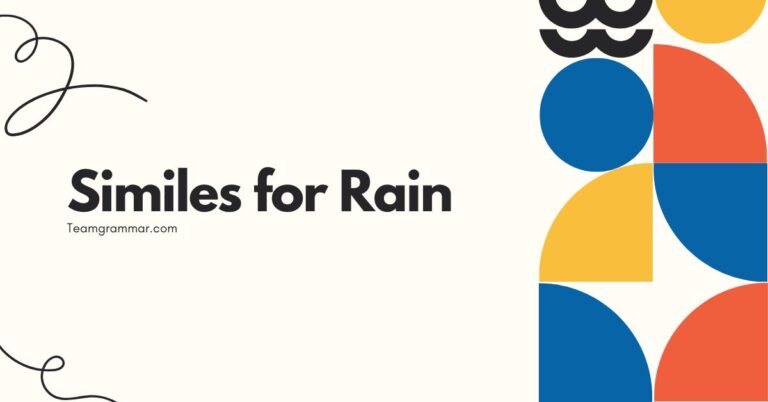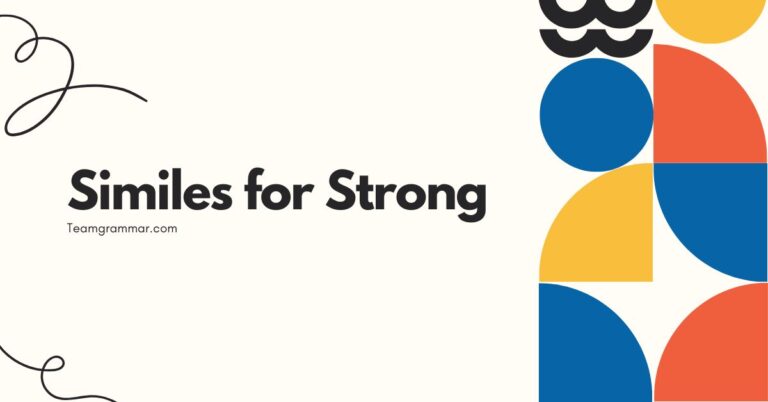31 Similes for Scared: Mastering Figurative Language
Understanding and using similes effectively is crucial for enriching your writing and speech. Similes allow you to express emotions and ideas in a vivid and relatable way.
This article focuses on similes that describe fear, providing you with a comprehensive guide to enhance your descriptive abilities. Whether you’re a student, writer, or language enthusiast, this guide provides clear explanations, numerous examples, and practical exercises to help you master the art of using similes for conveying fear.
Table of Contents
- Introduction
- Defining Similes and Fear
- Structural Breakdown of Similes
- Types of Similes for Scared
- Examples of Similes for Scared
- Usage Rules for Similes
- Common Mistakes When Using Similes
- Practice Exercises
- Advanced Topics in Similes
- Frequently Asked Questions
- Conclusion
Defining Similes and Fear
Asimileis a figure of speech that compares two unlike things using the words “like” or “as.” Its primary function is to create a vivid image or enhance understanding by drawing a parallel between something familiar and something less so. Similes are essential tools in descriptive writing and speech, allowing writers and speakers to convey emotions, ideas, and sensory experiences in a more engaging and relatable manner.
They help to paint a picture in the reader’s or listener’s mind, making the description more impactful and memorable.
Fear, on the other hand, is an emotional response to perceived threats. It can manifest physically through symptoms like a racing heart, trembling, and sweating.
Psychologically, fear can lead to feelings of anxiety, panic, and a sense of helplessness. The intensity and expression of fear can vary widely depending on the individual, the situation, and cultural factors.
Using similes to describe fear allows us to capture these nuances and convey the emotion more effectively.
Simile Classification
Similes can be classified based on what they emphasize: the intensity of the emotion, the physical manifestation, or the psychological impact. For instance, a simile like “as white as a sheet” focuses on the physical manifestation of fear, while “like a deer caught in headlights” emphasizes the psychological aspect of being paralyzed by fear.
Simile Function
The function of a simile is to draw a comparison that illuminates a particular aspect of the subject. In the context of fear, similes can highlight the suddenness, intensity, or debilitating effect of the emotion.
They can also be used to create a specific mood or atmosphere in a narrative.
Contexts for Using Similes
Similes describing fear are commonly used in literature, poetry, and even everyday conversation. In literature, they help to create suspense, build character, and immerse the reader in the story.
In poetry, similes can add depth and emotional resonance to the verses. In everyday conversation, they can help to express feelings and experiences more vividly.
Structural Breakdown of Similes
The basic structure of a simile involves three key elements: the subject being described (A), the word “like” or “as,” and the object of comparison (B). The structure is “A is like/as B.” Understanding this structure is crucial for creating effective and grammatically correct similes.
The subject (A) is the entity experiencing the fear. This could be a person, animal, or even an abstract concept like a nation or organization.
The object of comparison (B) is something that shares a similar characteristic or quality with the subject, particularly in the context of fear. This could be anything from a frightened animal to a natural phenomenon associated with danger or unease.
The words “like” and “as” act as the bridge between the subject and the object of comparison. They signal that a comparison is being made and that the two entities are not literally the same but share some common attribute.
The choice between “like” and “as” often depends on the specific phrasing and rhythm of the sentence.
For example, in the simile “He was as pale as a ghost,” “He” is the subject (A), “as” is the connecting word, and “a ghost” is the object of comparison (B). This structure highlights the pallor associated with both fear and ghosts, creating a vivid image of the person’s frightened appearance.
Common Simile Patterns
Several common patterns appear in similes describing fear. One common pattern involves comparing the subject to a frightened animal, such as “like a rabbit caught in headlights.” Another involves comparing the subject to a fragile object, such as “as fragile as glass.” These patterns provide a framework for creating new and original similes.
Grammatical Rules for Similes
When constructing similes, it’s important to ensure grammatical accuracy. The subject and object of comparison should be grammatically parallel.
For example, it’s correct to say “He ran like the wind” but incorrect to say “He ran like wind.” The article “the” is necessary to make the comparison grammatically sound.
Types of Similes for Scared
Similes for “scared” can be categorized based on the aspect of fear they emphasize: physical reactions, emotional states, and behavioral responses. Each category provides a unique way to describe the experience of fear.
Similes Describing Physical Reactions
These similes focus on the physical manifestations of fear, such as trembling, sweating, and changes in skin color. They help to convey the immediate and visceral impact of fear on the body.
Examples include: “as white as a sheet,” “shaking like a leaf,” and “sweating like a pig.” These similes use familiar images to illustrate the physical sensations associated with fear, making them easily relatable to the reader or listener.
Similes Describing Emotional States
These similes focus on the internal emotional experience of fear, such as anxiety, panic, and helplessness. They help to convey the psychological impact of fear on the individual.
Examples include: “like a deer caught in headlights,” “as anxious as a cat in a dog pound,” and “feeling like his heart would explode.” These similes use vivid imagery to capture the intensity and overwhelming nature of fear.
Similes Describing Behavioral Responses
These similes focus on the actions and behaviors that result from fear, such as running away, hiding, or freezing in place. They help to convey the behavioral consequences of fear and how it can affect a person’s actions.
Examples include: “running like his life depended on it,” “hiding like a mouse from a cat,” and “frozen like a statue.” These similes use action-oriented language to illustrate how fear can drive behavior.
Examples of Similes for Scared
The following tables provide a comprehensive collection of similes for “scared,” categorized by the aspect of fear they emphasize. Each table includes a variety of examples to illustrate the different ways in which similes can be used to describe fear.
Physical Reactions Similes Examples
This table presents examples of similes that describe the physical reactions associated with fear. These similes focus on observable changes in the body, such as trembling, sweating, and changes in skin color.
The goal is to provide a vivid and relatable depiction of the physical experience of fear.
| Simile | Explanation |
|---|---|
| As white as a sheet | Describes extreme paleness due to fear. |
| Shaking like a leaf | Describes uncontrollable trembling. |
| Sweating like a pig | Describes excessive sweating due to anxiety. |
| His heart was pounding like a drum | Describes a racing heartbeat. |
| His knees were like jelly | Describes weak and unsteady legs. |
| Her hands were as cold as ice | Describes cold and clammy hands due to fear. |
| His voice was trembling like a reed | Describes a shaky and unsteady voice. |
| His breath came in gasps, like a fish out of water | Describes labored and rapid breathing. |
| Her skin crawled like ants were marching on it | Describes a sensation of unease and discomfort. |
| His stomach churned like a washing machine | Describes nausea and digestive discomfort. |
| As stiff as a board | Describes muscle tension and rigidity. |
| His hair stood on end like needles | Describes the sensation of hair standing up due to fear. |
| His face was ashen, like a corpse | Describes a pale and lifeless complexion. |
| His eyes were wide like saucers | Describes dilated pupils due to fear. |
| His throat was dry like sandpaper | Describes a dry and constricted throat. |
| Her teeth chattered like castanets | Describes uncontrollable teeth chattering. |
| His pulse raced like a hummingbird’s wings | Describes a very rapid pulse. |
| His blood ran cold like ice water | Describes a chilling sensation of fear. |
| His legs felt like lead | Describes heavy and difficult-to-move legs. |
| He was breathing heavily, like a marathon runner | Describes labored breathing from exertion and fear. |
| He shuddered like a dog after a bath | Describes an involuntary bodily tremor. |
| His muscles were tight as a drum | Describes extreme muscle tension. |
| His body was rigid, like a statue | Describes a state of physical immobility. |
Emotional States Similes Examples
This table presents examples of similes that describe the emotional states associated with fear. These similes focus on internal feelings such as anxiety, panic, and helplessness.
The goal is to provide a nuanced and insightful depiction of the psychological experience of fear.
| Simile | Explanation |
|---|---|
| Like a deer caught in headlights | Describes being paralyzed by fear. |
| As anxious as a cat in a dog pound | Describes extreme anxiety and unease. |
| Feeling like his heart would explode | Describes overwhelming panic. |
| As helpless as a baby bird fallen from its nest | Describes a sense of complete vulnerability. |
| Like a prisoner awaiting execution | Describes dread and anticipation of something terrible. |
| As terrified as a mouse cornered by a snake | Describes intense fear and a sense of impending doom. |
| Like a nightmare come to life | Describes a horrifying and surreal experience. |
| As vulnerable as a newborn lamb | Describes extreme vulnerability and defenselessness. |
| Like walking on eggshells | Describes a state of constant anxiety and caution. |
| As scared as a child lost in a crowd | Describes feelings of disorientation and abandonment. |
| Like being trapped in a coffin | Describes a sense of claustrophobia and dread. |
| As afraid as a soldier facing the enemy | Describes intense fear in a dangerous situation. |
| Like a leaf in a storm | Describes feeling tossed around and helpless. |
| As vulnerable as a turtle without its shell | Describes a state of extreme exposure and risk. |
| Like waiting for a bomb to explode | Describes a state of tense anticipation. |
| As exposed as a raw nerve | Describes extreme sensitivity and vulnerability. |
| Like being on a roller coaster | Describes a mix of excitement and fear. |
| As fearful as a lamb before slaughter | Describes a sense of impending doom. |
| Like a boat lost at sea | Describes feeling disoriented and alone. |
| As panicked as a bird in a cage | Describes a feeling of being trapped and desperate. |
| Like drowning in a sea of despair | Describes a feeling of overwhelming sadness and hopelessness. |
| As terrified as a clown in a horror movie | Describes an ironic and unsettling fear. |
| Like a ghost in his own life | Describes feeling detached and unreal. |
Behavioral Responses Similes Examples
This table presents examples of similes that describe the behavioral responses associated with fear. These similes focus on actions and behaviors such as running away, hiding, or freezing in place.
The goal is to provide a dynamic and engaging depiction of how fear can influence behavior.
| Simile | Explanation |
|---|---|
| Running like his life depended on it | Describes running with extreme speed and urgency. |
| Hiding like a mouse from a cat | Describes seeking refuge to avoid danger. |
| Frozen like a statue | Describes being unable to move due to fear. |
| Clinging like a vine to a wall | Describes desperately holding on for support. |
| Screaming like a banshee | Describes a loud and piercing scream. |
| Cowering like a whipped dog | Describes shrinking back in fear and submission. |
| Trembling like an earthquake | Describes violent and uncontrollable shaking. |
| Staring like a zombie | Describes a blank and unfocused gaze. |
| Fleeing like refugees from a war zone | Describes a desperate and chaotic escape. |
| Whispering like a ghost | Describes speaking in a barely audible voice. |
| Jumping like a startled cat | Describes a sudden and involuntary reaction. |
| Crying like a baby | Describes inconsolable weeping. |
| Panicking like a flock of birds | Describes a sudden and chaotic rush. |
| Stuttering like a broken record | Describes difficulty speaking due to nervousness. |
| Hesitating like a deer at a fence | Describes uncertainty and reluctance. |
| Looking around like a cornered animal | Describes a frantic and suspicious gaze. |
| Shrinking like a violet | Describes drawing back and becoming inconspicuous. |
| Huddling like penguins in a storm | Describes seeking warmth and protection in a group. |
| Crawling like an insect | Describes moving slowly and cautiously. |
| Gasping like a dying man | Describes struggling for breath. |
| Darting around like a hummingbird | Describes quick and erratic movements. |
| Acting like a scaredy cat | Describes being overly cautious and fearful. |
| Clawing like a wild animal | Describes desperate attempts to escape. |
Usage Rules for Similes
Using similes effectively requires understanding several key rules. These rules ensure that your similes are clear, impactful, and grammatically correct.
Following these guidelines will enhance your writing and help you convey emotions and ideas more effectively. A well-crafted simile can elevate your writing from mundane to memorable.
Clarity and Relevance
The comparison in your simile should be clear and relevant. The reader should easily understand the connection between the subject and the object of comparison.
Avoid obscure or overly complex comparisons that may confuse the reader.
For example, instead of saying “He was as scared as a quark in a quantum field,” which might not be immediately understandable to everyone, you could say “He was as scared as a mouse in a room full of cats.” The latter is much more relatable and easier to grasp.
Originality and Freshness
While some similes are common and widely understood, strive for originality and freshness in your comparisons. Overused similes can become clichés and lose their impact.
A unique and creative simile can capture the reader’s attention and make your writing stand out.
Instead of always using “as white as a sheet,” consider alternatives like “as pale as moonlight” or “ashen like a statue.” These fresh comparisons can add depth and nuance to your descriptions.
Grammatical Correctness
Ensure that your similes are grammatically correct. The subject and object of comparison should be parallel in structure.
Use the correct form of “like” or “as” based on the context of the sentence.
For example, it’s correct to say “She ran like the wind” but incorrect to say “She ran like wind.” The article “the” is necessary to make the comparison grammatically sound. Also ensure the tense of verb is consistent.
Contextual Appropriateness
Consider the context in which you are using the simile. The comparison should be appropriate for the tone and style of your writing.
Avoid using overly casual or humorous similes in serious or formal contexts.
For instance, in a formal essay, it would be more appropriate to say “He was as apprehensive as a diplomat entering a hostile negotiation” rather than “He was as scared as a chicken with its head cut off.”
Avoiding Mixed Metaphors
Be careful to avoid mixed metaphors or similes that combine unrelated images or ideas. This can create confusion and undermine the effectiveness of your writing.
Keep your comparisons consistent and logical.
An example of a mixed metaphor is: “He was swimming in a sea of doubt, but he stood his ground like a rock.” The image of swimming clashes with the image of standing firm, creating a confusing and contradictory picture.
Common Mistakes When Using Similes
Even experienced writers can make mistakes when using similes. Being aware of these common errors can help you avoid them and improve the quality of your writing.
This section highlights some frequent pitfalls and provides examples of how to correct them.
Overusing Clichés
Mistake: Relying too heavily on overused and predictable similes.
Correct vs. Incorrect Examples:
- Incorrect: He was as scared as a ghost.
- Correct: He was as pale as moonlight, his features barely visible in the dim light.
The correct example uses a fresher, more descriptive comparison.
Inappropriate Comparisons
Mistake: Using similes that don’t fit the context or tone of the writing.
Correct vs. Incorrect Examples:
- Incorrect: The battle was as fun as a trip to Disneyland.
- Correct: The battle was as fierce as a storm raging at sea.
The correct example uses a simile that aligns with the seriousness of the subject.
Grammatical Errors
Mistake: Making grammatical errors in the structure of the simile.
Correct vs. Incorrect Examples:
- Incorrect: She sings like a bird.
- Correct: She sings like a bird sings. Or She sings like a nightingale.
The correct example uses a parallel structure for the comparison.
Unclear Comparisons
Mistake: Using similes that are confusing or difficult to understand.
Correct vs. Incorrect Examples:
- Incorrect: He was as scared as a fractal.
- Correct: He was as scared as someone lost in a maze, unable to find their way out.
The correct example uses a more relatable and understandable comparison.
Mixed Metaphors and Similes
Mistake: Combining unrelated images or ideas in a single simile.
Correct vs. Incorrect Examples:
- Incorrect: He was drowning in a sea of fear, but his courage stood like a mountain.
- Correct: He was drowning in a sea of fear, struggling to keep his head above the waves.
The correct example maintains a consistent image throughout the simile.
Practice Exercises
Test your understanding of similes with these practice exercises. Each exercise focuses on different aspects of simile usage, from identifying similes to creating your own.
Answers are provided at the end of the section.
Exercise 1: Identifying Similes
Identify the similes in the following sentences.
| Question | Answer |
|---|---|
| 1. He ran as fast as a cheetah. | as fast as a cheetah |
| 2. Her voice was like silk. | like silk |
| 3. The snow was falling softly. | (No simile) |
| 4. The moon was as bright as a spotlight. | as bright as a spotlight |
| 5. He was as quiet as a mouse. | as quiet as a mouse |
| 6. She was as light as a feather. | as light as a feather |
| 7. The car was very fast. | (No simile) |
| 8. He was as brave as a lion. | as brave as a lion |
| 9. The food tasted like heaven. | tasted like heaven |
| 10. The pillow felt like a cloud. | felt like a cloud |
Exercise 2: Completing Similes
Complete the following similes with an appropriate ending.
| Question | Answer |
|---|---|
| 1. He was as scared as a _______. | mouse |
| 2. She was shaking like a _______. | leaf |
| 3. His face was as white as _______. | a sheet |
| 4. He ran like _______. | the wind |
| 5. She hid like _______. | a shadow |
| 6. His heart was pounding like a _______. | drum |
| 7. He was frozen like _______. | a statue |
| 8. She was as helpless as _______. | a baby bird |
| 9. He felt like _______. | he might faint |
| 10. She looked like _______. | she had seem a ghost |
Exercise 3: Creating Similes
Create your own similes to describe the following situations.
| Situation | Example Answer |
|---|---|
| 1. The feeling of being lost in a dark forest. | Like being swallowed by the night itself. |
| 2. The sound of thunder during a storm. | Like the roar of a giant beast awakening. |
| 3. The sight of a spider crawling on your skin. | Like tiny needles pricking your flesh. |
| 4. The feeling of anticipation before a scary movie. | Like waiting for a rollercoaster to drop. |
| 5. The experience of walking through a haunted house. | Like stepping into another world of shadows and fear. |
| 6. The feeling of being watched. | Like eyes boring into the back of your head. |
| 7. The sensation of a cold hand touching your shoulder. | Like ice spreading through your veins. |
| 8. The fear of public speaking. | Like standing naked before a crowd of strangers. |
| 9. The anxiety of waiting for test results. | Like waiting for a verdict that could change your life. |
| 10. The horror of seeing a ghost. | Like a nightmare materializing before your eyes. |
Advanced Topics in Similes
For advanced learners, exploring more complex aspects of similes can further enhance their understanding and usage. This section delves into subtle nuances and advanced techniques that can elevate simile usage to a higher level.
Extended Similes
An extended simile, also known as a Homeric simile, is a detailed and often lengthy comparison that spans several lines or even paragraphs. It allows for a more elaborate and nuanced comparison, providing a deeper insight into the subject being described.
Extended similes are often used in epic poetry and literary prose to create vivid imagery and enhance the emotional impact of the narrative.
Example: “He was as scared as a lone traveler lost in a vast desert, with the sun beating down mercilessly, mirages shimmering on the horizon, and the constant fear of running out of water driving him to the brink of despair, each step a testament to his will to survive.”
Subverted Similes
A subverted simile is a simile that deliberately deviates from the expected or conventional comparison. It can be used to create humor, irony, or a sense of unease.
By challenging the reader’s expectations, subverted similes can add a layer of complexity and sophistication to the writing.
Example: “He was as brave as a coward hiding behind a shield, pretending to be fearless while trembling inside.”
Philosophical Similes
These similes are used to illustrate abstract or philosophical concepts. They often draw comparisons between complex ideas and more concrete, relatable experiences.
Philosophical similes can help to make abstract concepts more accessible and understandable.
Example: “Fear is like a dark room, where negatives develop.” This simile connects the abstract concept of fear with the tangible process of developing photographs, making the emotional impact of fear more relatable.
Frequently Asked Questions
This section addresses common questions about similes, providing clear and concise answers to help you deepen your understanding.
- What is the difference between a simile and a metaphor?
- Can a simile be a cliché?
- How can I make my similes more effective?
- Is it okay to use similes in formal writing?
- What are some common mistakes to avoid when using similes?
- How do I identify a simile in a sentence?
- Can similes be used in poetry?
- What is the purpose of using similes?
- How can I improve my ability to create similes?
- Are some words better to use in similes than others?
A simile explicitly compares two things using “like” or “as,” while a metaphor directly equates two things without using these words. For example, “He is like a lion” (simile) vs.
“He is a lion” (metaphor).
Yes, overused similes can become clichés. To avoid this, try to create original and fresh comparisons.
Focus on clarity, relevance, and originality. Choose comparisons that are easily understood and appropriate for the context.
Yes, but use them judiciously. Ensure that the similes are appropriate for the tone and style of the writing.
Avoid clichés, inappropriate comparisons, grammatical errors, and unclear comparisons.
Look for the words “like” or “as.” If a comparison is being made using these words, it’s likely a simile.
Yes, similes are commonly used in poetry to create vivid imagery and enhance the emotional impact of the verses.
The purpose of similes is to create a vivid image or enhance understanding by drawing a parallel between something familiar and something less so.
Practice regularly, read widely, and pay attention to the comparisons that others use. Experiment with different combinations of subjects and objects of comparison.
Yes, words that evoke strong sensory images or emotions are often more effective in similes. For example, using words like “silk,” “ice,” or “thunder” can create a more vivid and impactful comparison.
Conclusion
Mastering the art of using similes for “scared” involves understanding their structure, types, and usage rules. By exploring numerous examples and avoiding common mistakes, you can effectively enhance your writing and speech.
Similes provide a powerful tool for conveying emotions and ideas in a vivid and relatable manner. Practice regularly, strive for originality, and pay attention to the context in which you are using similes.
With dedication and attention to detail, you can elevate your descriptive abilities and create compelling and memorable prose.
Remember that the key to effective simile usage lies in clarity, relevance, and freshness. Strive to create comparisons that are easily understood, appropriate for the context, and original in their expression.
By incorporating these principles into your writing, you can unlock the full potential of similes and transform your descriptions from ordinary to extraordinary. Keep practicing and experimenting with different combinations of subjects and objects of comparison to develop your unique style and voice.







